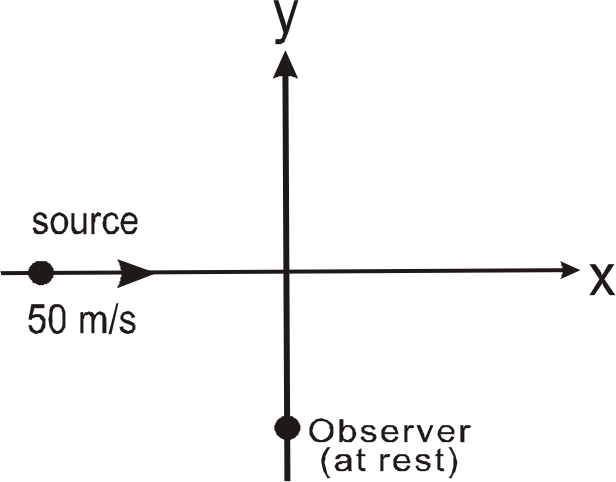In the absence of air source and observer moves away 20 m/s. The frequency observed by the observer is 1800 Hz and velocity of sound in air is 340 m/s then find original frequency of source
To solve the problem, we will use the Doppler effect formula for sound, which relates the frequency observed by an observer to the frequency emitted by a source when both the source and observer are in motion.
Given Data:
- Frequency observed by the observer (f') = 1800 Hz
- Velocity of sound in air (v) = 340 m/s
- Velocity of the observer (v_o) = 20 m/s (moving away from the source)
- Velocity of the source (v_s) = 20 m/s (moving away from the observer)
1. Understand the Doppler Effect Formula:
The formula for the observed frequency when both the source and observer are moving away from each other is given by:
f′=v−vov+vs⋅f
where:
- f′ = observed frequency
- f = original frequency of the source
- v = speed of sound in air
- vo = speed of the observer
- vs = speed of the source
2. Substitute the Known Values:
We know:
- f′=1800 Hz
- v=340 m/s
- vo=20 m/s
- vs=20 m/s
Plugging these values into the formula gives:
1800=340−20340+20⋅f
3. Simplify the Equation:
Calculate the terms in the fraction:
1800=320360⋅f
4. Cross-Multiply to Solve for f:
Rearranging the equation:
1800⋅360320=f
5. Calculate the Value of f:
Now calculate the right side:
f=1800⋅360320
Simplifying the fraction:
f=1800⋅1.125=2025 Hz
Final Answer:
The original frequency of the source f is 2025 Hz.
- Frequency observed by the observer (f') = 1800 Hz
- Velocity of sound in air (v) = 340 m/s
- Velocity of the observer (v_o) = 20 m/s (moving away from the source)
- Velocity of the source (v_s) = 20 m/s (moving away from the observer)
The formula for the observed frequency when both the source and observer are moving away from each other is given by:
f′=v−vov+vs⋅f
where:
- f′ = observed frequency
- f = original frequency of the source
- v = speed of sound in air
- vo = speed of the observer
- vs = speed of the source
We know:
- f′=1800 Hz
- v=340 m/s
- vo=20 m/s
- vs=20 m/s
1800=340−20340+20⋅f
Calculate the terms in the fraction:
1800=320360⋅f
Rearranging the equation:
1800⋅360320=f
Now calculate the right side:
f=1800⋅360320
Simplifying the fraction:
f=1800⋅1.125=2025 Hz
The original frequency of the source f is 2025 Hz.
Topper's Solved these Questions
- JEE MAIN 2021BOOK - JEE MAINS PREVIOUS YEARCHAPTER - JEE MAIN 2021EXERCISE - SECTION-A
80 Videos
- JEE MAIN 2021BOOK - JEE MAINS PREVIOUS YEARCHAPTER - JEE MAIN 2021EXERCISE - SECTION-B
40 Videos
- JEE MAINBOOK - JEE MAINS PREVIOUS YEARCHAPTER - JEE MAINEXERCISE - All Questions
473 Videos
- JEE MAIN 2022BOOK - JEE MAINS PREVIOUS YEARCHAPTER - JEE MAIN 2022EXERCISE - Question
492 Videos
Similar Questions
A listener is at rest and a police siren is moving away from the listerner at 60m/s. what frequency does the listerner hear given that the velocity of sound in air is 340m/s and frequency os siren is 500Hz?
View SolutionA listener is at rest and a police siren is moving away from the listerner at 60m/s. what frequency does the listerner hear given that the velocity of sound in air is 340m/s and frequency os siren is 500Hz?
View Solution
Knowledge Check
A sound source moving with speed 50 m/s along x-axis and observer at rest on y-axis.If the frequency observed by observer when source crosses the origin is 96 Hz, then the original frequency of source is :(speed of sound is given medium is 200 m/s)
 A90 HzB100 HzC80 HzD60 Hz
A90 HzB100 HzC80 HzD60 HzA source of sound is travelling towards a stationary observer. The frequency of sound heard by the observer is 25% more than the actual frequency. If the speed of sound is v, that of the source is
A3.5 m/sB3.5 cm/sC3.5 ft/sDzeroA source of sound is moving towards a high wall with a speed of 20 m/s. The frequency of the sound produced by the source is 400 Hz. If the speed of the sound is 340 m/s, then the beat frequency heard by a person standing near the wall will be
AzeroB5C10D2
At particular instant a source of sound of frequency 1000 Hz is at (2m,1m) and an observer is at (5m,5m). The velocity of source and observer are 30(ˆi+ˆj)m/sand15(ˆi+√3ˆj)m/s respectively at this instant. The velocity of sound in air is 330 m/s. find the frequency and wavelength of sound received by the observer.
View SolutionA source of sound, producing a sinusoidal wave, is moving uniformly towards an observer at a velocity of 20 m/s. The observer is moving away from the source at a constant velocity of 10 m / s. Frequency of the source is 200 Hz and speed of sound in air is of 340 m/s. (a) How many times, in an interval of 10 second, the eardrums of the observer will sense maximum change in pressure? (b) What will be apparent wavelength of sound for the observer?
View SolutionAn observer is moving away from source of sound of frequency 100 Hz. His speed is 33 m/s. If speed of sound is 330 m/s, then the observed frequency is
View SolutionAn observer moves towards a stationary source of sound of frequency n . The apparent frequency heard by him is 2 n . If the velocity of sound in air is 332 m/sec, then the velocity of the observer is
View SolutionA train is moving with a uniform speed of 33 m/s and an observer is approaching the train with the same speed. If the train blows a whistle of frequency 1000 Hz and the velocity of sound is 333 m/s, then the apparent frequency of the sound that the observer hears is
View Solution
